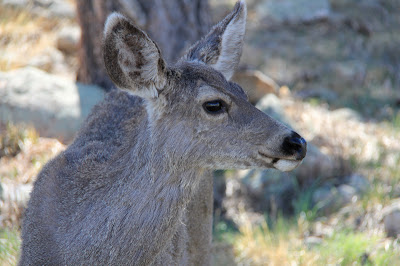Distance: 6 miles round trip
Elevation: 7,318 ft -7,689 ft
Elevation Gain: 877 ft cumulative
Dogs: Off leash, BLM land
Bathroom at Trailhead: No
Date Hiked: 24 October 2014
 |
| The Turret Trail in the Browns Canyon Wilderness Study Area is a study in diversity. |
The Browns Canyon Wilderness Study Area near Buena Vista is a 22,000 acre chunk of transitional land that is part open grassland, part scraggy forest, and part granite hoodoo. This route travels through all three of these zones in a dizzying display of diversity. The Collegiate Peaks (Mt. Princeton, Harvard, and Yale) block the western horizon. They rise a dramatic 5000 ft above the
surrounding valley in a wall that Nature surely put in place to keep out the teaming hordes from the western slope.
 |
| View of Mt. Princeton from the trailhead |
 |
| Heading up the initial slope |
 |
| On the initial saddle |
The trailhead is marked with large signs indicating the study area and even has a couple of interpretive plaques. The route starts up a rocky gully between two hills until it reaches a small saddle at only 0.2 miles. Be sure to turn left here. An old road/eroded ditch heads to the right, which is slightly confusing.
 |
| Turning left and heading away the mountains |
 |
| A not-so-unusal trail segment. Rock and trees. |
 |
| The trail winds up and down small hillsides. This is the view from a top one of them. |
The trail continues to climb for another 0.5 miles to a high point (300 ft gain) before beginning a series of descents and ascents over rock outcroppings, down gullies, and along and across several washes. There is no signage or cairns, and in several locations we had to rely on tracks in the loose sand to guide our way.
 |
| On another hill looking out over the Collegiate Peaks |
 |
| Coming out into the wash. Turn right here and follow it around the bend. |
 |
| The one trail sign. It points up the slope and out of the wash. |
At 1.2 miles is a very large wash. The route actually travels IN this wash (to the right) and around a bend to the southwest until one of the few signs (at 1.35 miles) takes the hiker out of the wash and up onto a open grassland plateau. From this point it is wide-open skies all the way to the junction with the River Bench Trail (at 2 miles). The Turret Trail heads left, while the River Bench Trail travels around to the right of an eroded hillside filled with more hoodoos. It was at this point that we came across several Mule Deer that leapt and flew, leapt and flew, across our path in an effortless ballet that would have made Mikhail Baryshnikov's nickers twist with envy.
 |
| Artwork on the fence post leading out onto the grassland plateau |
 |
| The plateau was crisscrossed with small washes. |
 |
| Heading across the plateau |
The River Bench Trail dead ends (at 2.9 miles) at backcountry campsite complete with a central fire pit and luxurious logs. The Arkansas River, charming and sedate in the fall, a tad more perky in the spring, flowed just out of reach down a steep embankment. With such a view, we had to drag ourselves away to return to the car. Next time I will bring a gourmet lunch and contemplate the river through a glass of wine.
 |
| Passing around the hillside |
 |
| More hoodoos along the way. Mountain Lion territory. |
 |
| Mule Deer with Mt. Yale in the background |
Browns Canyon is up for National Monument consideration. We only scratched the surface of this unique area on this trip but the unusual combination of granite outcroppings, Ponderosa and Limber Pine forest, and Sagebrush grasslands was really a treat. Colorado is blessed with so many interesting ecosystems. The one found in Brown's Canyon is both fun to play in and deserving of protection. I hope the powers in Washington, who don't always understand the West and our culture, decide to preserve it. Regardless, take a trip to Beuna Vista and check it out for yourself.
 |
| The campsite |
 |
| The lovely view of the Arkansas River |




































